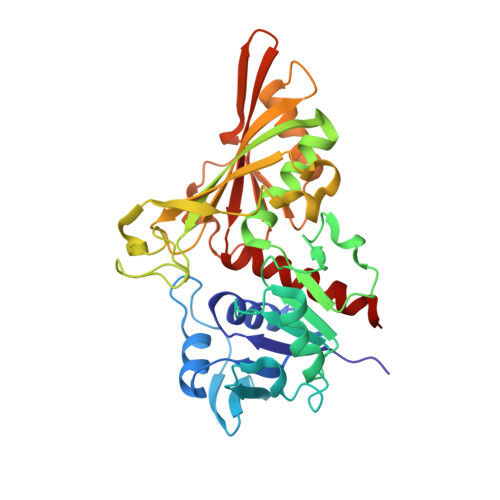Crystal Structure of Glyceraldehyde-3-Phosphate Dehydrogenase 1 from Methicillin-Resistant Staphylococcus aureus MRSA252 Provides Novel Insights into Substrate Binding and Catalytic Mechanism.
Mukherjee, S., Dutta, D., Saha, B., Das, A.K.(2010) J Mol Biology
- PubMed: 20620151
- DOI: https://doi.org/10.1016/j.jmb.2010.07.002
- Primary Citation of Related Structures:
3HQ4, 3K73, 3K9Q, 3KSD, 3KSZ, 3KV3, 3L4S, 3L6O, 3LC1, 3LC2, 3LC7, 3LVF - PubMed Abstract:
The dreaded pathogen Staphylococcus aureus is one of the causes of morbidity and mortality worldwide. Glyceraldehyde-3-phosphate dehydrogenase (GAPDH), one of the key glycolytic enzymes, is irreversibly oxidized under oxidative stress and is responsible for sustenance of the pathogen inside the host. With an aim to elucidate the catalytic mechanism and identification of intermediates involved, we describe in this study different crystal structures of GAPDH1 from methicillin-resistant S. aureus MRSA252 (SaGAPDH1) in apo and holo forms of wild type, thioacyl intermediate, and ternary complexes of active-site mutants with physiological substrate d-glyceraldehyde-3-phosphate (G3P) and coenzyme NAD(+). A new phosphate recognition site, "new P(i)" site, similar to that observed in GAPDH from Thermotoga maritima, is reported here, which is 3.40 A away from the "classical P(i)" site. Ternary complexes discussed are representatives of noncovalent Michaelis complexes in the ground state. d-G3P is bound to all the four subunits of C151S.NAD and C151G.NAD in more reactive hydrate (gem-di-ol) form. However, in C151S+H178N.NAD, the substrate is bound to two chains in aldehyde form and in gem-di-ol form to the other two. This work reports binding of d-G3P to the C151G mutant in an inverted manner for the very first time. The structure of the thiaocyl complex presented here is formed after the hydride transfer. The C3 phosphate of d-G3P is positioned at the "P(s)" site in the ternary complexes but at the "new P(i)" site in the thioacyl complex and C1-O1 bond points opposite to His178 disrupting the alignment between itself and NE2 of His178. A new conformation (Conformation I) of the 209-215 loop has also been identified, where the interaction between phosphate ion at the "new P(i)" site and conserved Gly212 is lost. Altogether, inferences drawn from the kinetic analyses and crystal structures suggest the "flip-flop" model proposed for the enzyme mechanism.
- Department of Biotechnology, Indian Institute of Technology, Kharagpur, Pin-721302, West Bengal, India.
Organizational Affiliation:

















